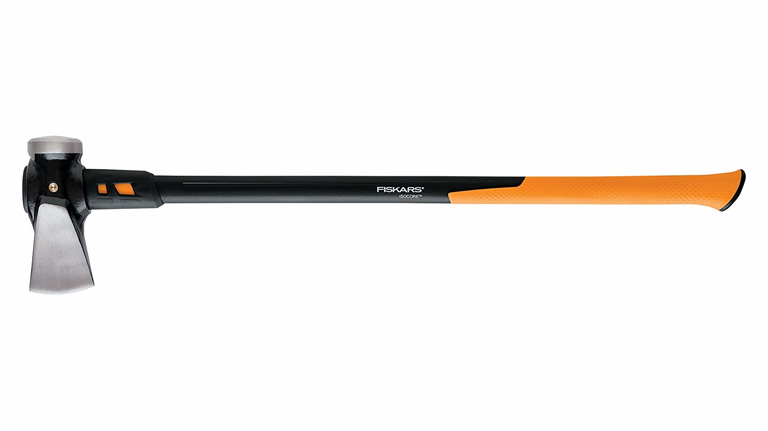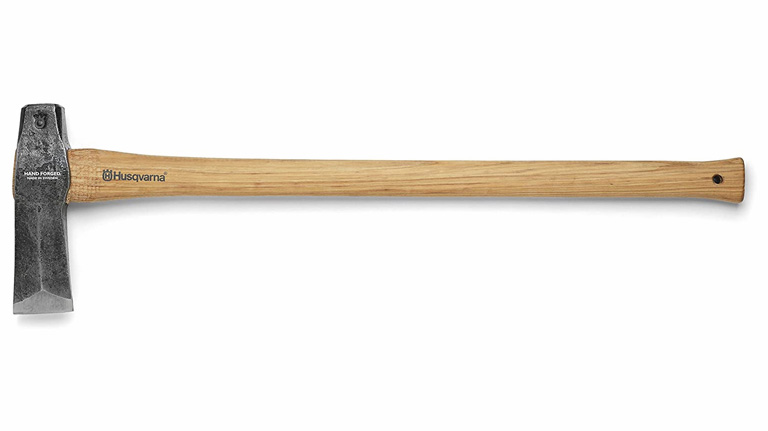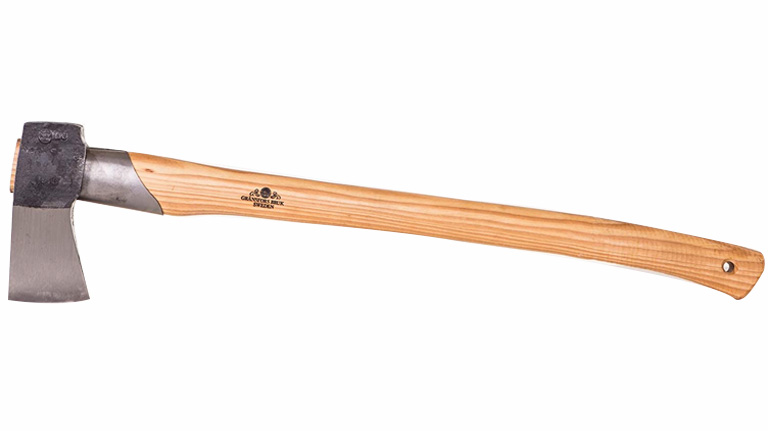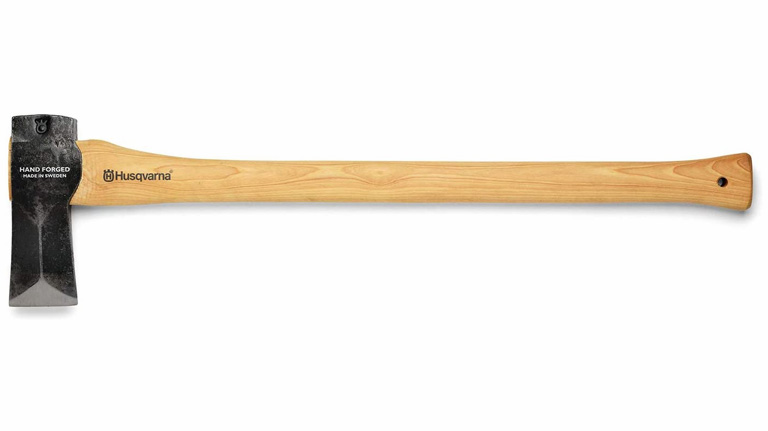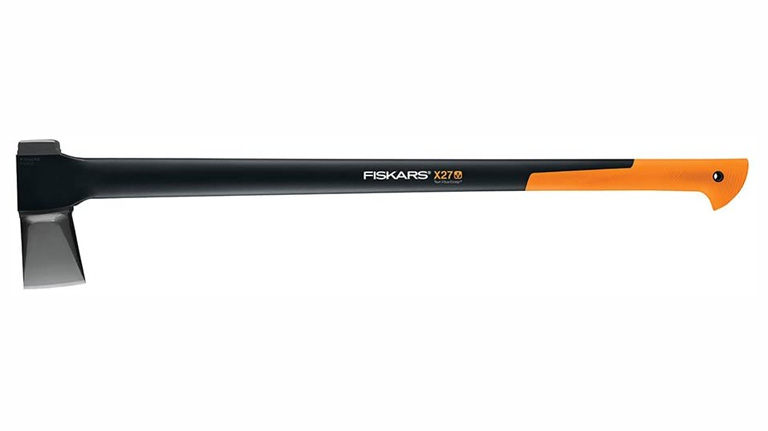If you plan on splitting your way through a large wood pile the right tool will make a world of difference. Choosing the right splitting maul or axe will help keep this task from becoming a pain in the … well … back side.
Both are quite similar as both are designed to split logs along the grain of the wood, but the biggest difference is the weight of the head. A splitting maul head weighs in between 6 and 8 pounds while a splitting axe will weigh between 3 and 6 pounds.
Product Name | Weight | Rating | Handle Length |
|---|---|---|---|
Top pick | 10.4 pounds | 36 Inch | |
8.5 Pounds | 36 inches | ||
6.8 pounds | 32 inches | ||
7 pounds | 31.5 inches | ||
7 pounds | 27.5 inches | ||
4.6 pounds | 30 inches | ||
4.6 pounds | 36 inches | ||
0.4 pounds | 14 inches |
How to split wood
There is no great science to using a splitting maul or axe, but it does take some skill to wield safely and effectively.
It is critical to have a stable platform or chopping block to put the log on, if it is unstable it becomes a major safety issue which could cause the maul or axe to ricochet off and strike your leg.
Identify a hairline crack in the surface of the end of the log and use it to split the wood. Keep in mind the type of wood will determine how it splits — oak splits in the center and maple comes apart at the end grains.
Take aim at your target and move the maul or axe in an up and down motion instead of swinging it, with your weaker hand on the end of the handle and your dominant hand higher up. Cut the wood to your desired size but do not be deterred if the wood does not split on the first attempt, it will normally take a few attempts.
A maul can also be used as a wedge and tapped through a stubborn log using a sledge hammer. It is not recommended to use an axe in this way, though wedges can be used to free an axe that has become pinched or wedged in a piece of wood by hammering them through a crack just like a maul.
What is a splitting maul?
A splitting maul is also known as a blockbuster, a block splitter, a chop and maul, a sledge axe and a number of other handles. But it’s design and function is much more straightforward than that. It is basically a sledgehammer on one end with a dull axe blade on the other end.
It has a long handle to give the person swinging it leverage.
This is a powerhouse designed for one thing: Splitting large logs.
Like a sledgehammer it is also quite heavy, coming in at anywhere from 3-5 pounds heavier than an axe.
With this design a maul splits wood by forcing the fibers apart, parallel to the grain. The dull edge and V-shaped head forces the crack apart with momentum and pressure.
Due to its size and weight it can be cumbersome to use, especially over long periods of time.
They are made with a steel head and with a handle that is usually made from wood or synthetic materials, usually fiberglass. This comes down to personal preference.
Wood handles are generally made from hardwoods like hickory or ash or maple as it will reduce cracking and the length of the handle will help reduce vibrations. They also have the added advantage of being replaceable if they do end up breaking.
A fiberglass handle has a few advantages as well. They are lighter which is key if you are working through a large wood pile and need to keep fatigue at bay. They also absorb vibrations well and are more durable than wood handles, but if they do break they can not be replaced.
Why pick a splitting maul over an axe?

Splitting large logs
This is where the maul excels. Everything about the sledge axe is designed to take large logs and turn them into fuel for fire. It’s design, size and weight make it optimal for splitting stumps or large rounds into firewood.

Splitting hardwood
The maul’s size also makes it effective when working with hardwood. Maple, oak, ash and birch are great for making fires that burn hot and for long periods of time and a hamaxe is the perfect tool for cutting the logs down to size.

Versatility
OK, so there is only one main use for a maul, cutting big logs into smaller more fire-friendly sizes, however, there is more than one way to split wood. If the maul is not making it through with a traditional swing, it can be used like a wedge. First drive the axe edge into the log, then hit the blunt end with a sledgehammer to drive it through. This can be particularly effective with hardwoods.
The top 3 splitting mauls
The Fiskars IsoCore Maul is one of the top reviewed mauls on the market for a reason, it’s IsoCore Shock Control handle is a game changer. It is a multi-layered system that eliminates much of the vibration caused by contact with the wood.
This helps lessen the strain on joints reducing fatigue and the amount of ibuprofen you will need at the end of a long day. The handle also comes with a softgrip handle with a sculpted profile to fit the natural shape of your hand.
But it goes beyond just the handle.
The design of the forged steel head makes it ideal for splitting or driving through with the help of a sledgehammer and is inseparable from the handle.
It is on the heavy end of the spectrum for mauls, but it works like a machine.
Head weight | 8 pounds |
Total Weight | 10.4 pounds |
Length | 36 inches |
Handle | IsoCore Shock Control System |
The Helko Werk maul head is easily recognizable due to its unique large wedge shape and leaves little doubt about its purpose as a heavy-duty wood splitter. The shape of the high-carbon steel head helps ensure it does not get stuck or pinched when it is being swung. It is more than capable of splitting tree trunks, large rounds or hardwood.
The Helko Werk splitter comes with a gorgeous hickory handle with a linseed oil finish and sanded smooth to help prevent blisters over the course of a long day. Meanwhile, the 36-inch handle gives you the leverage to cut through the gnarliest of logs.It is also almost two pounds lighter than the Fiskars entry which adds up in a hurry.
The Helko Werk comes with a full-grain leather sheath and a 1-ounce bottle of axe guard protective oil to keep the maul in top condition.
The Vario 2000 is also beautiful to look at, but that beauty is more than just skin deep.
It is on the higher end of the price range for a maul, but if you’re looking for a workhorse it is worth every penny.
Head weight | 6.7 pounds |
Total Weight | 8.5 pounds |
Length | 36 inches |
Handle | Wood |
There is nothing pretty about this maul, but splitting wood has little to do with beauty. To that end, this Swedish-made sledge axe hangs with the best of them. It’s smaller and lighter than both the Fiskars and Helko maul’s but it does not lack in ability, in fact it may save some wear and tear on the body.
The hand-forged steel head is longer and narrower than the other two mauls on this list, but that does help in its versatility to either swing it or to drive it through with a sledge hammer. It also comes with a leather edge cover to protect it while in storage or not being used.
The 32-inch hickory handle is unfinished but gives the user the option to leave it raw or to give it the finish they desire. Though it may lose some power with the shorter handle, it gains in accuracy.
It is also the most affordable of these three axes, giving you perhaps the most bang for your buck.
Head weight | 5.5 pounds |
Total Weight | 6.8 pounds |
Length | 32 inches |
Handle | Wood |
** Honourable Mention **
This is the smallest of the mauls listed but it is also the most expensive. It is a quality wood splitter, but it does lack some of the power its larger competitors offer. It is actually not that much bigger than Granfors Bruk’s splitting axe.
The maul also has many similar design elements as the axe, including its concave blade which cuts into the wood before splitting it off at its widest points. The extra weight, however, along with bevelled corners, turn it into a striking wedge.
Like the axe, the handle comes with a protective steel collar below the head and circular grooves towards the end of the hickory handle for an improved grip.
Despite the size and price, it is still an effective maul for splitting thick and knotty chunks of wood.
Head weight | 5.5 pounds |
Total Weight | 7 pounds |
Length | 31.5 inches |
Handle | Wood |
What is a splitting axe?
A splitting axe is not that different from a maul, but this is a case where size does matter.
The axe is more narrow, shorter and generally sharper than a maul. They perform much the same function but the axe is a little easier to wield due to its size. It will not pack quite the punch that a maul will, but it should allow you to work longer before you wear down.
The construction of a splitting axe is similar to a maul, but the head weighs just 3 to 6 pounds.
The head will be much thinner than a maul which allows it to sink into the wood and use its momentum to sink through the wood, splitting it apart as it gets closer to the eye of the axe head.
The splitting axe also has a shorter handle, adding to its versatility as it will be much more easy to maneuver and use safely.
Just like a maul, they are made with a steel head and a handle generally made from wood or synthetic materials.
Wood handles are generally made from hardwoods like hickory or ash or maple as it will reduce cracking and the length of the handle will help reduce vibrations. Again, they can also be replaced if they do break.
A fiberglass handle has a few advantages as well. For one, they are lighter which will help keep your endurance up as you work through a cord of wood. They also absorb vibrations well and are more durable than wood handles, but if they do break they can not be replaced.
One-piece steel axes are available and are pretty much indestructible, but they can only be used for short periods of time due to the vibrations they create.
It all comes down to what you will be most comfortable with.
Why pick an axe over a splitting maul?

You're splitting large amounts of wood
If you are settling in for an afternoon of splitting a cord of wood for the winter, your arms will last much longer using a tool that weighs about half as much as a maul. It is also easier to use due to its smaller size, allowing for a more accurate swing.

Versatility
It’s calling card is splitting wood, but it can also be used for a little bit of chopping if need be, though it is not recommended for felling a tree. It is also a little easier to use an axe over a maul to split logs down into kindling or starting fuel, though a hatchet will still be your best bet when breaking wood down to this size. Still, it is an option with a splitting axe.

You are smaller
Safety first and always. If you are a smaller individual a splitting axe may be the best route, regardless of the task. At 3-6 pounds, it is much easier to control than a full-sized maul that, with the handle included, can weigh more than 10 pounds. The size of the splitting axe will allow for a more accurate and controlled swing.

Transportability
You likely are not taking a full-sized splitting axe with you on a hike, but if you’re heading out for a weekend of camping, it is a lot easier to throw this in the back of the truck than a maul, which you may want a sledgehammer with as well.
The top 3 axes
This is your Cadillac of axes, and you will pay for it. But you also get what you pay for. The Gransfors Bruk Large Splitting Axe head is forged and ground to a concave shape, from a very thin edge to much wider at the eye of the axe, allowing for ease of splitting.
The axe head also forms a protective steel collar around the handle where it connects with the head. A vegetable-tanned leather sheath is included with the axe.
Gransfors Bruk does offer a small version at 3.5 pounds and 23 inches, but if your intention is to split wood to compete with a maul then you’ll want the larger axe for its leverage and weight.
Head weight | 5 pounds |
Total Weight | 7 pounds |
Length | 27.5 inches |
Handle | Wood |
This light-weight axe from Husqvarna features a long hickory handle that gives you extra power for splitting larger logs, it may struggle, however, with harder and knottier pieces of wood.
But, it is also light enough to allow you to cut all day long.
The head is designed to go easily into wood with minimal effort and is hand-forged from high-quality Swedish steel.
The axe is also well balanced, allowing for a clean, smoothe stroke.mFor safe storage and transport, the axe comes with a leather edge cover.
The Husqvarna 30-inch Wooden Split axe lacks a little of the firepower of some of the bigger axes, but it is quick and easy to grab and to start splitting firewood.
Head weight | 2.75 pounds |
Total Weight | 4.6 pounds |
Length | 30 inches |
Handle | Wood |
The FiskarsSuper Splitting axe is ideal for taller users or those looking for a little extra leverage which will provide the power needed to split medium-extra-large sized logs. The axe combines balanced weight distribution, blade design, an ultra-sharp edge and a virtually unbreakable design to allow the blade to split wood more effectively.
The axe head comes in a unique convex blade shape which adds power and makes it easier to remove from wood.
This is the longest axe handle Fiskars makes giving you more power, but can take a little extra time to get used to swinging it. Like the maul, it is made from both composite and steel and features the Iso-core shock-absorber for added durability and comfort and to take away some of the vibrations.
The axe comes with a plastic guard to protect the edge on the axe and those it may come in contact with.
There are some concerns over the quality of steel, especially when cutting through harder, knottier wood, but at this price point Fiskars Super Splitting Axe still packs a wallop.
Head weight | 2.75 pounds |
Total Weight | 4.6 pounds |
Length | 36 inches |
Handle | Fiber composite |
** Honourable Mention **
This one is a bit of a wildcard — part maul, part axe, great for splitting a log on the fly while you sit around a fire or need to break off some smaller shards for kindling and starter.
The Estwing Fireside Friend is forged in one piece of steel and its dimensions give it a surprising amount of wood-splitting power. Its size also makes it easy to swing safely, while its maul head is great for driving splitting wedges.
Though the Estwing entry is made of steel, its shock-absorbing cover takes away 70% of the vibrations from contact.
This is not a tool you will want to use for hours on end, but to split a couple of logs quickly, it is tough to beat its versatility, ease of use and portability.
Total Weight | 0.4 pounds |
Length | 14 inches |
Handle | Steel |
Conclusion
Splitting maul or splitting axe — it all comes down to the job ahead of you.
If you are staring down a pile of hickory you will need the power and weight of a maul to get the job done. But if a truck has just unloaded a cord of pine in your yard, a lighter splitting axe will likely be the better option to take you through the afternoon. An axe can also be wielded safely by more people giving it an edge in versatility.
As always, choose carefully.
Three pounds of weight can make a ton of difference when splitting wood and it’s best to have the right tool for the job.

Carlo’s introduction to the wilderness was during his stint in geothermal and geological surveying, which brought him to remote and unusual hiking spots all over Southeast Asia. His outdoor experience has made him an expert in axes and other types of saws.









